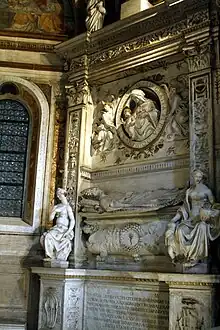Juan de Castro
Juan de Castro (1431–1506) (called the Cardinal of Agrigento) was a Spanish Roman Catholic bishop and cardinal.
His Eminence Juan de Castro | |
|---|---|
| Cardinal Bishop of Agrigento | |
 Tomb of Juan de Castro in Santa Maria del Popolo, Rome | |
| Church | Roman Catholic |
| Diocese | Agrigento |
| Appointed | 19 February 1479 |
| In office | 1479-1506 |
| Predecessor | Domenico Xarth |
| Successor | Giuliano Cibò |
| Other post(s) | Cardinal-Priest of Santa Prisca |
| Orders | |
| Created cardinal | 19 February 1496 by Alexander VI |
| Rank | Cardinal-Priest |
| Personal details | |
| Born | March 22, 1431 |
| Died | September 29, 1506 (aged 75) Rome, Italy |
| Buried | Santa Maria del Popolo |
| Nationality | Spanish |
Biography
Juan de Castro was born in Valencia on March 22, 1431, the son of nobles Pedro Galcerán de Castre-Pinòs y Tramaced and Blanca de Só, viscountess of Évol.[1]
He began his ecclesiastical career as a cleric in the see of Elne.[1] He was later the Abbot of Fossanova Abbey.[1] He was a familiar of Cardinal Roderic Llançol i de Borja, who later became Pope Alexander VI.[1]
On February 19, 1479, he was elected Bishop of Agrigento.[1] Pope Sixtus IV confirmed his election on March 20, 1479, and Castro subsequently occupied this see until his death.[1] He attended the papal conclave of 1484 as a custodian.[1] Following the papal conclave of 1492, the new pope, Alexander VI, made Castro prefect of the Castel Sant'Angelo.[1]
Pope Alexander VI made him a cardinal priest in the consistory of February 19, 1496.[1] He received the red hat and the titular church of Santa Prisca on February 24, 1496.[1] From the time of his promotion to the cardinalate, he lived in Rome permanently, participating in the ceremonies, consistories and religious feasts and celebrating masses; he was the executor of the will of Cardinal Bartolomé Martí.[1]
On November 6, 1499, he became the apostolic administrator of the see of Schleswig, occupying this post until July 29, 1502.[1] He became involved in a dispute with two mother superiors at the Monastery of Pedralbes; this led to Ferdinand II of Aragon on March 12, 1500, forbidding Cardinal Castro to interfere in the affairs of the monastery.[1]
He participated in the papal conclave of September 1503 that elected Pope Pius III and in the papal conclave of October 1503 that elected Pope Julius II.[1]
In 1506, he became the Apostolic Administrator of Malta, although Ferdinand II had requested that bishopric for another cardinal who succeeded in the same year.[1]
He died in Rome on September 29, 1506.[1] He is buried in Santa Maria del Popolo.[1]
References
- "Biography from the Biographical Dictionary of the Cardinals of the Holy Roman Church". Archived from the original on 2018-02-15. Retrieved 2012-06-23.
External links and additional sources
- Cheney, David M. "Archdiocese of Agrigento". Catholic-Hierarchy.org. Retrieved June 16, 2018. (for Chronology of Bishops)[self-published]
- Chow, Gabriel. "Metropolitan Archdiocese of Agrigento (Italy)". GCatholic.org. Retrieved June 16, 2018. (for Chronology of Bishops) [self-published]